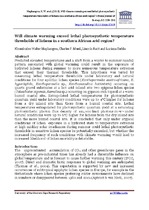| dc.contributor.author | Maphangwa, Khumbudzo Walter | |
| dc.contributor.author | Musil, Charles F. | |
| dc.contributor.author | Raitt, Lincoln | |
| dc.contributor.author | Zedda, Luciana | |
| dc.date.accessioned | 2017-07-13T13:56:59Z | |
| dc.date.available | 2017-07-13T13:56:59Z | |
| dc.date.issued | 2013 | |
| dc.identifier.citation | Maphangwa, K. W. et al. (2013). Will climate warming exceed lethal photosynthetic temperature thresholds of lichens in a southern African arid region? African Journal of Ecology, 52: 228 - 236 | en_US |
| dc.identifier.issn | 0141-6607 | |
| dc.identifier.uri | http://hdl.handle.net/10566/3073 | |
| dc.identifier.uri | http://dx.doi.org/10.1111/aje.12110 | |
| dc.description.abstract | Predicted elevated temperatures and a shift from a winter to summer rainfall pattern associated with global warming could result in the exposure of hydrated lichens during summer to more numerous temperature extremes that exceed their thermal thresholds. This hypothesis was tested by measuring lethal temperature thresholds under laboratory and natural conditions for four epilithic lichen species (Xanthoparmelia austro-africana, X. hyporhytida, Xanthoparmelia sp., Xanthomaculina hottentotta) occurring on quartz gravel substrates at a hot arid inland site two epigeous lichen species (Teloschistes capensis, Ramalina sp.) occurring on gypsum-rich topsoil at a warm humid coastal site. Extrapolated lethal temperatures for photosynthetic quantum yield under laboratory conditions were up to 4°C higher for lichens from a dry inland site than those from a humid coastal site. Lethal temperatures extrapolated for photosynthetic quantum yield at a saturating photosynthetic photon flux density of ≥11,000 µmol photons m-2s-1 under natural conditions were up to 6°C higher for lichens from the dry inland site than the more humid coastal site. It is concluded that only under atypical conditions of lichen exposure in a hydrated state to temperature extremes at high midday solar irradiances during summer could lethal photosynthetic thresholds in sensitive lichen species be potentially exceeded, but whether the increased frequency of such conditions with climate warming would lead to increased likelihood of lichen mortality is debatable. | en_US |
| dc.language.iso | en | en_US |
| dc.publisher | Wiley | en_US |
| dc.rights | This is the author-version of the article published online at: http://dx.doi.org./10.1111/aje.12110 | |
| dc.subject | Arid ecosystem | en_US |
| dc.subject | Climate warming | en_US |
| dc.subject | Lethal photosynthetic temperatures | en_US |
| dc.subject | Lichens | en_US |
| dc.subject | South Africa | en_US |
| dc.subject | Succulent | en_US |
| dc.subject | Karoo | en_US |
| dc.subject | Biome | en_US |
| dc.title | Will climate warming exceed lethal photosynthetic temperature thresholds of lichens in a southern African arid region? | en_US |
| dc.type | Article | en_US |
| dc.privacy.showsubmitter | FALSE | |
| dc.status.ispeerreviewed | TRUE | |
| dc.description.accreditation | Web of Science | |

